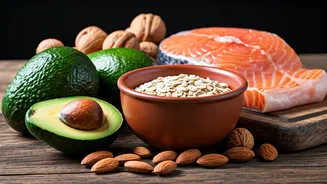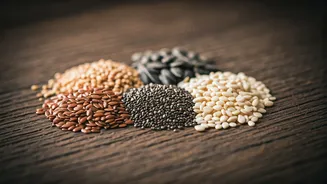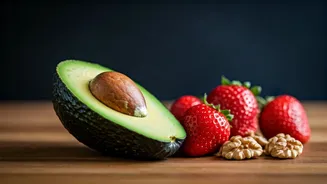Understanding Omega-3s
Omega-3 fatty acids play a crucial role in women's health, offering a range of benefits from heart health to cognitive function. These essential fats,
which the body cannot produce on its own, are necessary for various bodily processes. There are different types of omega-3s, including EPA (eicosapentaenoic acid) and DHA (docosahexaenoic acid), primarily found in marine sources, and ALA (alpha-linolenic acid), which is found in plant-based sources. Adequate intake is linked to reduced risk of heart disease, improved mood, and enhanced brain function. For women, omega-3s are especially beneficial, supporting hormonal balance and reproductive health. Incorporating omega-3s into your diet is a proactive step toward supporting long-term health and vitality. Understanding the importance of these essential fats sets the stage for making informed choices about dietary intake.
Embracing Fatty Fish
One of the most effective ways to boost omega-3 intake is by including fatty fish in your diet. Salmon, mackerel, sardines, and herring are all excellent sources of EPA and DHA. A serving of these fish, typically around 3–4 ounces, provides a significant dose of these vital fatty acids. Aim to consume fatty fish at least twice a week to reap the benefits. Consider grilling, baking, or steaming fish to preserve its nutritional value. If you're not a fan of fish, you can explore other options; however, fatty fish remains the most efficient dietary source. Preparing fish with herbs and spices can also enhance the flavour, making it a more enjoyable addition to your diet. Regular consumption of fatty fish contributes to overall heart health and cognitive function, making it a wise dietary choice.
Plant-Based Omega-3s
For those who prefer a plant-based diet or are looking for alternatives, ALA from plant sources offers another avenue for omega-3 intake. Flaxseeds, chia seeds, hemp seeds, and walnuts are all rich in ALA. These foods can be easily incorporated into meals and snacks. Sprinkle flaxseeds or chia seeds on your morning oatmeal or yogurt, add walnuts to salads, or use hemp seeds in smoothies. While the body needs to convert ALA into EPA and DHA, making these foods a valuable addition to your diet. The conversion rate can vary, making it important to consume a variety of ALA-rich foods to ensure adequate intake. These plant-based options are not only nutritious but also versatile and easy to include in various recipes. Regularly consuming these foods supports overall health and provides a sustainable way to increase your omega-3 intake, particularly for those following vegetarian or vegan diets.
Supplementing Wisely
If you struggle to meet your omega-3 needs through diet alone, supplementation can be a viable option. Fish oil and algae oil are common supplements providing EPA and DHA. When choosing a supplement, consider factors such as purity, dosage, and source. Look for brands that have been third-party tested to ensure quality and that the supplement is free from contaminants like heavy metals. The recommended dosage for omega-3 supplements varies, so it's best to consult a healthcare professional for personalized guidance. Algae oil provides an excellent alternative for vegetarians and vegans. Always adhere to the recommended dosage and consider the timing of when you take the supplement. Supplements serve as a convenient way to boost your omega-3 intake, complementing dietary efforts. Consulting a healthcare provider is an important step to ensure it aligns with your health goals and avoids potential interactions with other medications.
Boosting Your Intake
Increasing your omega-3 intake is about making small, sustainable changes in your daily routine. Start by consciously adding omega-3-rich foods to your meals each week. Try swapping less nutritious snacks for a handful of walnuts or incorporating chia seeds into your breakfast. Meal planning can help ensure that you consistently include omega-3 sources in your diet. Read food labels to check the omega-3 content of packaged foods. Be mindful of cooking methods; opt for baking or steaming over frying to preserve the nutritional value of your omega-3-rich foods. Regularly monitoring your diet and making small adjustments will support your overall well-being. By focusing on these simple strategies, you can improve your omega-3 intake and unlock the numerous health benefits they offer. Creating an easy and enjoyable plan can make this process a part of your lifestyle.











